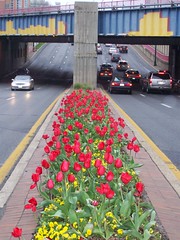So a couple tenants have signed on to Ballpark Village.
Kansas City-based Polsinelli Shalton Flanigan Suelthaus PC (whew!) is consolidating its downtown and Clayton offices in Ballpark Village.Brokerage and investment firm Stifel Financial Corp., already located downtown, is in as well.And, in some of the best news yet, the Urban Blue's Ballpark Lofts are selling like gooey butter cakes--in a terrible market, especially for condos.So we have an urban village on the west side of the Ballpark. Let's just call that Ballpark Village.
We have confirmed tenants just north of the stadium. Great. Let's throw in some residential and more offices, and that will be the northern part of the Village.
To the south, we have major opportunities. Sure the potential Village to the south is cut off by Highway 40. But there needs to be a push to fill in some vacant lots and build structured parking instead of surface lots just south of the stadium. I would like to see enough infill and new activity to pull pedestrians post-ballgame down to the "Broadway Blues District"--with the incomparable trio of
BB's,
Beale on Broadway, and the
Broadway Oyster Bar miraculously surviving spates of decline and demolition in that area.
View Larger MapCheck out the above map (zoom in to the "A"). Cerre Street is riddled with mixed-use (office, residential, retail, other commercial, even light industrial) potential. Build one structured parking facility on the west end of Cerre (forcing everyone to walk down the street toward new street-level retail). Have this parking garage extend below ground to accommodate for heavy ballgame traffic. Then, ninety percent of the rest of Cerre would be dedicated to a Village atmosphere. As I mentioned, perhaps we'd see some spillover and some real connection between downtown (specifically, this Ballpark Village) and the Broadway Blues District just to the south. Let's do that, and let's call that the Village as well.
But the biggest opportunity is the east of the District.
View Larger MapThat monster needs to go ASAP. That whole city block could be a series of "row house" style, 4-5 story commercial/residential buildings that would quickly become a hot address. This would bring activity and a
1000 percent aesthetic improvement to four blockfaces downtown. Another option, depending on demand, could be high or mid-rise office/residential towers.
Let's not forget this beautiful surface lot between the excellent Pointe 400 building and the stadium itself:
View Larger MapAgain, opportunities are endless. New high rise towers or smaller scale urban infill--it doesn't matter. It would be an amazing improvement and would go a long way in crafting a Village atmosphere that has been so often discussed. Plus, development on this large block could very well tie Ballpark Village to
Chouteau's Landing, and specifically to that development's Historic Fourth Street area. Let's do all those things, and let's call them all collectively, Ballpark Village.
Of course, the issue here would be--ahem--parking, parking, parking. Of course, there'd still be room for a couple smaller, multi-story garages with retail on the bottom. Ultimately, though, the city needs to do whatever it can to confine most of the parking underground. The vitality of the Village would be amplified so much if unsightly parking was subterranean, and the Village had a more pedestrian-friendly look and feel to it. And so, yes, that means, sadly, the now historic twin-Busch garage on the west should come down too.
If we realized
this Village, we'd have a true urban neighborhood on our hands, befitting of the very term "Village".
Because, when I think of Village, I think of an active, comfortable, inviting space where people always congregate--not a sterile, cramped collection of office towers and chain restaurants smashed into the old Busch footprint.
If we're going to build this Village, we should set our sights higher, or, perhaps more appropriately, we should set those sights
wider. That means a recognition that the real Village will (or should, at least) go beyond the current borders of that old footprint. It should absorb the Ballpark Lofts, the Westin, Cerre Street, the Broadway Blues District, Chouteau's Landing, and all adjacent parcels.
Just some thoughts.







